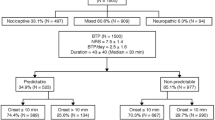Abstract
Introduction
Breakthrough cancer pain is defined as a transient exacerbation of pain that occurs spontaneously or in response to a trigger, despite stable and controlled background pain. Breakthrough pain often causes significant functional impairments for patients and can decrease quality of life.
Objective
The objective of the study was to determine differences between breakthrough cancer pain incidence and management in Canada and Europe.
Methods
Data collected from previous studies of breakthrough cancer pain in Canada and Europe was compared. A standard survey with identical inclusion/exclusion criteria was utilized for both patient populations.
Results
Both groups of patients had a similar number and duration of breakthrough pain episodes, and similar pain intensity and pain interference with their daily activities. European patients reported better analgesic efficacy and satisfaction with management, and a greater percentage of European patients were prescribed a transmucosal fentanyl formulation (19.1 vs 2.9 %). More European patients (55 %) than Canadian patients (32.5 %) took their rescue medication every time they had a breakthrough pain episode.
Conclusions
Breakthrough cancer pain in both Canadian and European patients greatly impacts their daily living, and both groups of patients had similar experiences with breakthrough cancer pain. Currently, this pain is not adequately managed for many patients. The role for new analgesic treatments in management of breakthrough cancer pain needs further study.
Similar content being viewed by others
References
van den Beuken-van Everdingen MH, de Rijke JM, Kessels AG, Schouten HC, van Kleef M, Patijn J (2007) Prevalence of pain in patients with cancer: a systematic review of the past 40 years. Ann Oncol 18(9):1437–1449
World Health Organization. WHO’s cancer pain ladder for adults. 2014; Available at: http://www.who.int/cancer/palliative/painladder/en/. Accessed 10 March 2014
Davies AN, Dickman A, Reid C, Stevens AM, Zeppetella G, Science Committee of the Association for Palliative Medicine of Great Britain and Ireland (2009) The management of cancer-related breakthrough pain: recommendations of a task group of the Science Committee of the Association for Palliative Medicine of Great Britain and Ireland. Eur J Pain 13(4):331–338
Mercadante S, Radbruch L, Caraceni A, Cherny N, Kaasa S, Nauck F et al (2002) Episodic (breakthrough) pain: consensus conference of an expert working group of the European Association for Palliative Care. Cancer 94(3):832–839
Webber K, Davies AN, Cowie MR (2011) Breakthrough pain: a qualitative study involving patients with advanced cancer. Support Care Cancer 19(12):2041–2046
Mercadante S, Ferrera P, Adile C, Casuccio A (2011) Fentanyl buccal tablets for breakthrough pain in highly tolerant cancer patients: preliminary data on the proportionality between breakthrough pain dose and background dose. J Pain Symptom Manag 42(3):464–469
Mercadante S (2012) Pharmacotherapy for breakthrough cancer pain. Drugs 72(2):181–190
Bedard G, Hawley P, Zhang L, Slaven M, Gagnon P, Bisland S et al (2013) A survey of Canadian cancer patients’ perspectives on the characteristics and treatment of breakthrough pain. Support Care Cancer 21(9):2557–2563
Davies A, Buchanan A, Zeppetella G, Porta-Sales J, Likar R, Weismayr W et al (2013) Breakthrough cancer pain: an observational study of 1000 European oncology patients. J Pain Symptom Manag 46(5):619–628
Deandrea S, Corli O, Consonni D, Villani W, Greco MT, Apolone G (2014) Prevalence of breakthrough cancer pain: a systematic review and a pooled analysis of published literature. J Pain Symptom Manag 47(1):57–76
Davis MP (2011) Fentanyl for breakthrough pain: a systematic review. Expert Rev Neurother 11(8):1197–1216
Mercadante S, Arcuri E (2007) Pharmacological management of cancer pain in the elderly. Drugs Aging 24(9):761–776
Davies A, Zeppetella G, Andersen S, Damkier A, Vejlgaard T, Nauck F et al (2011) Multi-centre European study of breakthrough cancer pain: pain characteristics and patient perceptions of current and potential management strategies. Eur J Pain 15(7):756–763
Black B, Herr K, Fine P, Sanders S, Tang X, Bergen-Jackson K et al (2011) The relationships among pain, nonpain symptoms, and quality of life measures in older adults with cancer receiving hospice care. Pain Med 12(6):880–889
Ferrell BR, Juarez G (2002) Cancer pain education for patients and the public. J Pain Symptom Manag 23(4):329–336
Ward SE, Goldberg N, Miller-McCauley V, Mueller C, Nolan A, Pawlik-Plank D et al (1993) Patient-related barriers to management of cancer pain. Pain 52(3):319–324
Conflict of interest
None.
Author information
Authors and Affiliations
Corresponding author
Rights and permissions
About this article
Cite this article
Bedard, G., Davies, A., McDonald, R. et al. Breakthrough cancer pain: a comparison of surveys with European and Canadian patients. Support Care Cancer 23, 791–796 (2015). https://doi.org/10.1007/s00520-014-2426-6
Received:
Accepted:
Published:
Issue Date:
DOI: https://doi.org/10.1007/s00520-014-2426-6




